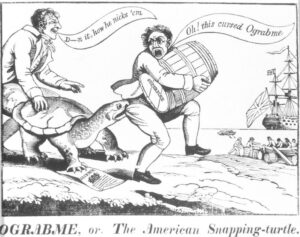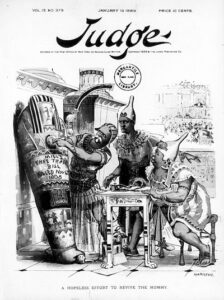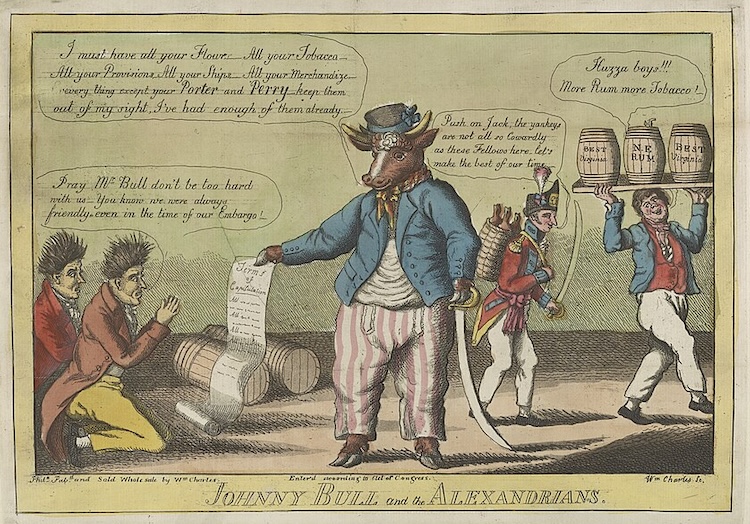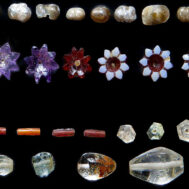
Ograbme, or the American Snapping Turtle. 1807 political cartoon relating to the Thomas Jefferson administration embargo. Ograbme is embargo backwards. Indiana University Library, public domain.
U.S. President Trump’s recent tariff announcements have introduced confusion and something close to panic within the international art and antiques trade. The directive, unveiled in an April 2 Rose Garden press conference and set to take effect on 9 April, introduced tariffs ranging from 10% to 54% on goods from over 60 countries. As well as swinging wildly from announcement to announcement, the implications for art are even less clear.
Initially, the sweeping tariff regime was set to impose a baseline 10% duty on all imports, with higher rates for specific countries—up to 125% on Chinese goods. However, facing global market volatility and diplomatic pressure, the administration announced a 90-day pause on the higher tariffs for most countries, maintaining the 10% baseline during this period.
Among the most affected countries, if the tariffs are applied to art, would be China (54%), India (26%), Japan (24%), the European Union (20%), and the UK (10%). These rates would be in addition to any existing tariffs.
On April 10, the White House confirmed that China would face a minimum tariff rate of 145% on all imports to the U.S., following Trump’s announcement of a 125% increase in tariffs on Chinese goods. The 125% increase is in addition to a prior 20% tariff, imposed due to China’s role in supplying fentanyl to the U.S. The 145% rate is a minimum, not a cap—it can go higher depending on existing and future tariffs.
Except for China, the higher country-specific rates will be suspended until July 9, 2025.
Trump’s use of the International Emergency Economic Powers Act (IEEPA) of 1977 adds another layer of legal ambiguity. Additionally, the International Emergency Economic Powers Act (IEEPA) includes provisions that protect “informational materials,” which encompass artworks, from import restrictions. Although the U.S. Harmonized Tariff Schedule explicitly exempts cultural property—including paintings, sculptures, prints, and antiquities over 100 years old—legal experts and art market professionals remain divided on whether these exemptions still apply under the new emergency powers.

Judge Magazine, 19 Jan 1889, Free Trade cover cartoon. Public domain.
An April 7, 2025 Art Newspaper article by Daniel Grant (before the announced 90-day hiatus) provided a number of reasonable responses to tariffs questions, although distinguished legal experts were divided on the answers and on how to interpret the various White House pronouncements. Nicholas M. O’Donnell of Sullivan & Worcester suggested that artworks should remain exempt under the IEEPA. Conversely, Michael McCullough of Pearlstein & McCullough contended that all foreign-made artworks were subject to the 10% tariff, with higher rates for certain countries.
Art institutions and dealers are seeking clear guidance. The International League of Antiquarian Booksellers noted that while tariffs can have an impact on the manufacture of new items, when applied to antique goods they made no sense whatsoever and the Confédération Internationale des Négociants en Œuvres d’Art (CINOA) pointed out that the art trade was made up primarily of individuals and micro-businesses and have no impact on trade imbalances. Both also focused on negative consequences to education and scholarship.
Already, the art market is experiencing a downturn, with global sales declining by 12% in 2024 for art in general and specialties like antiquities and ethnographic art suffering even more. While the 90-day pause offers temporary relief, the lack of definitive guidance on the application of tariffs to artworks continues to threaten the fragile, intensely globally-oriented art trade.
 Johnny Bull and the Alexandrians (1814) By William Charles Engraving, Political cartoon. John Bull: "I must have all your Flour,_ All your Tobacco,_ All your Provisions,_ All your Ships,_ All your Merchandize,_ every thing except your Porter and Perry,_ keep them out of my sight, I've had enough of them already." 1814, public domain.
Johnny Bull and the Alexandrians (1814) By William Charles Engraving, Political cartoon. John Bull: "I must have all your Flour,_ All your Tobacco,_ All your Provisions,_ All your Ships,_ All your Merchandize,_ every thing except your Porter and Perry,_ keep them out of my sight, I've had enough of them already." 1814, public domain. 

